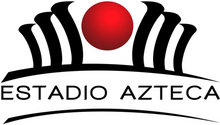
Back ملعب أزتيكا Arabic ستاد ازتيكا ARZ Estadiu Azteca AST ازتکا ایستادیومو AZB Stadion Azteca BAN Ацтека (стадион) Bulgarian আসতেকা স্টেডিয়াম Bengali/Bangla Estadi Azteca Catalan Aztécký stadion Czech Estadio Azteca Danish
El Coloso de Santa Úrsula "The Colossus of Santa Úrsula" | |
 | |
 Aerial view of the stadium | |
 | |
| Former names | Estadio Guillermo Cañedo (1997–1998) |
|---|---|
| Location | Coyoacán, Mexico City |
| Coordinates | 19°18′11″N 99°09′02″W / 19.30306°N 99.15056°W |
| Public transit | |
| Owner | Televisa |
| Operator | Ollamani, S.A.B.[1][2][3][4] |
| Executive suites | 856 |
| Capacity | 87,523[5] |
| Record attendance | Football: 119,853 (Mexico vs Brazil, 7 July 1968)[6] Boxing: 132,247 (Julio César Chávez vs Greg Haugen, 20 February 1993)[7] |
| Field size | 105 m × 68 m (344 ft × 223 ft) |
| Surface | Kikuyu Grass[8] |
| Scoreboard | Panasonic |
| Construction | |
| Broke ground | 1961 |
| Opened | 29 May 1966 |
| Renovated | 1986, 1999, 2013 and 2016[9] |
| Construction cost | MXN$260 million |
| Architect | |
| Tenants | |
| Club América (1966–present) Cruz Azul (1971–1996, 2018–2023) Mexico national football team (1966–present) Necaxa (1966–1971, 1982–2003) Atlante (1966–1982, 1996–2001, 2004–2007) UNAM (1967–1969) Atlético Español (1971–1982) | |
| Website | |
| estadioazteca.com.mx | |
Estadio Azteca (Latin American Spanish: [esˈtaðjo asˈteka]) is a football stadium located in Coyoacán, Mexico City.[10] It is the official home of football team Club América, as well as the Mexico national team. The stadium sits at an altitude of 2,200 m (7,200 feet) above sea level.[11] With a capacity of 87,523, it is the largest stadium in Latin America and the sixth-largest association football stadium in the world.
Regarded as one of the most famous and iconic football stadiums in the world,[12][13][14][15][16] it is the first to have hosted two FIFA World Cup finals;[17] the 1970 World Cup Final, where Brazil defeated Italy 4–1, and the 1986 World Cup Final, where Argentina defeated West Germany 3–2. It also hosted the 1986 quarter-final match between Argentina and England in which Diego Maradona scored both the "Hand of God goal" and the "Goal of the Century". The Estadio Azteca is the only football stadium in the world to have both Pelé (1970) and Diego Maradona (1986) win the FIFA World Cup, both of whom are considered among the greatest football players of all time. The stadium also hosted the "Game of the Century", when Italy defeated West Germany 4–3 in extra time in one of the 1970 semifinal matches. The stadium was also the principal venue for the football tournament of the 1968 Summer Olympics[18] and the 1971 Women's World Cup.[19] The stadium is scheduled to host games during the 2026 FIFA World Cup, including the opening game, making it the only stadium to host three editions of the FIFA World Cup.[20]
Additionally, the National Football League (NFL) features one game at Estadio Azteca per season as a part of its International Series.
- ^ "El América y el Estadio Azteca 'arriban' a la Bolsa Mexicana de Valores: Televisa realizará OPI". El Financiero (in Spanish). 25 January 2024.
- ^ "El Club América debutará en la Bolsa Mexicana de Valores". El País (in Spanish). 26 January 2024.
- ^ "América y Estadio Azteca: monetizar la pasión en la Bolsa de Valores". ESPN Deportes (in Spanish). 19 February 2024.
- ^ "Mexico's America, Azteca Stadium set for stock market listing ahead 2026 World Cup". Reuters. 19 February 2024.
- ^ "2026 FIFA World Cup Bid Book" (PDF). p. 161. Archived (PDF) from the original on 15 September 2021. Retrieved 5 April 2018.
- ^ "El Monumental le gana a la Bombonera como estadio más emblemático". 12 April 2013. Archived from the original on 27 June 2013.
- ^ "StadiumDB: Estadio Azteca". Retrieved 5 September 2013.
- ^ "The NFL in Mexico City: Last year will not be repeated! | SportsField Management". 5 August 2019.
- ^ "Historia #5". stadiumdb.com. Archived from the original on 25 March 2016. Retrieved 20 March 2016.
- ^ Mann, Chris (24 November 2009). "The 10 largest football stadiums in the world". soccerlens.com. Sports Lens. Archived from the original on 26 November 2009. Retrieved 24 November 2009.
- ^ Longman, Jeré (10 August 2009). "In Mexico, a Soccer Stadium Where Visitors Gasp". The New York Times. Retrieved 22 April 2017.
The massive bowl, Estadio Azteca, sits in the southern part of this sprawling metropolis like a concrete sombrero. The stadium's mystique—especially its 105,000 spectators and its 7,200-foot altitude—will play an integral role Wednesday in a World Cup qualifying match between Mexico and the United States.
- ^ "Ranking the Top 10 Most Iconic Stadiums in World Football". Bleacherreport. Retrieved 5 April 2013.
- ^ "Classic Stadium: Estadio Azteca". FIFA.com. Archived from the original on 16 July 2014.
- ^ Smart, Tony. "10 of the world's best sports venues". CNN. Retrieved 9 March 2012.
- ^ Mazur, Martin. "FourFourTwo's 100 Best Football Stadiums in the World: No.4". FourFourTwo. Retrieved 13 November 2015.
- ^ Gordon, Aaron (9 April 2013). "Mexico wins Mexican-American stadium war". Buzzfeed. Retrieved 9 April 2013.
- ^ "Mexico's historical stadium". FIFA.com. Archived from the original on 16 December 2012. Retrieved 31 May 2012.
- ^ 1968 Summer Olympics official report. Volume 2. Part 1. pp. 78–79.
- ^ Den glemte triumf: Da Danmark blev verdensmester i 1971 ['The forgotten triumph, when Denmark won the World Cup'] (in Danish)
- ^ Estadio Azteca: The Only Stadium To Have Three World Cups Now Mexico Will Co-Host 2026
© MMXXIII Rich X Search. We shall prevail. All rights reserved. Rich X Search